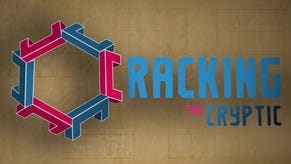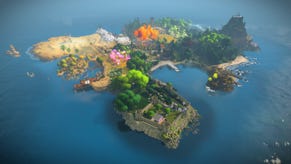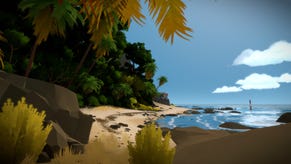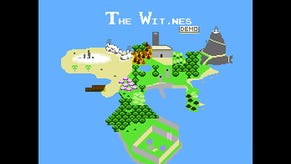The Great Outdoors: The Witness
How to build an island
While attending GDC I was thinking a lot about how "outdoors" works in videogames and speaking to artists and designers about how they had approached those environments. I was relatively early on in my experience of The Witness [official site] but I was intrigued by how many biomes were crammed onto a small island space without it ever feeling overcrowded. With that in mind I sat down with artist Luis Antonio to talk geography, architectural decay and why a simple handrail needs an entire backstory...
Before we start I should do the standard Witness spoiler disclaimer – we did this interview before I had gotten very far with the game at all and I was actively asking Antonio to keep from spoiling elements or puzzles I hadn't encountered yet. Having finished the game since then I'd say this is spoiler-free (to the point where I now have a whole new set of questions), but if you want to go into the game totally blind just bookmark this for later – I really enjoyed wandering the island, encountering all the different zones naturally.
We begin with a question about how you create the sense of expansiveness that I associate with outdoors when you only have a relatively small space to work within – in The Witness's case it's the island, which is small enough to walk around and then subdivides into these distinct biomes.
"You mention it like a limitation," says Antonio, "How do you create the notion of navigation through an open space with limits? We worked with landscape architects and architects and the way they did it was the other way around. They tried to build an island from scratch and how that would be and that gave us the scale which I think is the most important thing. It allowed us to have room to create all these biomes no matter how small they would be and naturally go between them."
I've done a separate post about the biomes on RPS, but that was more focusing on the colour palettes and how distinctive they were for each area. Something which surprise me, though, was that the transition as you walked out of one and into another didn't feel jarring, despite the clear differences of each setting. They're not jostling for your attention, if you know what I mean.
"Each area has a theme and we build the biome to speak about that theme, but [we] never really worried about the relationship between the connections. I think we knew it would naturally transition properly," says Antonio. "We do a lot with sightlines. So imagine you leave the entry yard and walk towards the agricultural area. We would take screenshots of that journey and see the framing and how that would feel. That's what we would tailor. So naturally you would focus on being inside an area at each point of the journey and that made it fluid. We never really focused on if it felt good to go between one and the other, it just did because they were never seen in isolation."
Part of that is also to do with movement speed, he adds. You can speed up if you want to go a little faster than walking, but you're never sprinting through areas in a way that means you're out of step with the scale of the island, getting anywhere too fast for the shifts to happen gently.
As part of a series of art blogs about the game (which I was reading with a sort of squint so I could shut my eyes at the first hints of a spoiler) Antonio talks about switching out a set of generic trees for a stylised version of a birch forest in one biome. With that and my previous conversations with Jane Ng about the trees of Firewatch in mind I asked about the importance of making those kinds of switches and the role of trees.
"I think the trees were a challenge visually, to achieve the look we were going for, but as a tool to create landscape they were as important as rocks or dirt or paths," he says. "I think we talked more about them because they were quite challenging to get them to look right."
But from there we end up talking more generally about the buildings and the evolution of the island. The involvement of architects and landscape architects led to conversations about the implied histories of objects and the development of the island itself over time – a sort of fictional history rooted in real geography and patterns of human activity.
Let's start with a castle:
"If you build a castle and the stones are too big, as an artist you don't think about this," says Antonio, "but [the architects] show you if the stones are too big it means they had to be carried by slaves which means you're implying there was a slave civilisation, that there was a monarchy - because it's not practical to carry huge blocks of stone – so you've got to make your stones smaller. You're like, 'Wow, we never thought about this' and you start to realise the implications of your decisions."
The implications of objects apply regardless of the size or perceived importance of that object. The stone size of a castle matters but so does the history and manufacture of something like a handrail.
"When you make stairs or you make handrails, artists very quickly do what they think a handrail should look like. But then the architects are like, 'This had to be manufactured in a factory, made out of pieces so it has to be modular, and it has to be carried in a truck or maybe we would have a dock, but if you have a dock it means you're bringing materials by boat so how do you carry those from the boat into the town? Do your paths have enough space for two horses?' This goes on and on."
The island itself is a volcanic island, so there's a volcano present but also associated volcanic geography. You can see it most clearly around the waterfall area and the side of the volcano/mountain which borders the ocean. They're crusted with columnar basalt which is that type of largely-hexagonal patchwork of columnar rock which makes up the Giant's Causeway. It forms when molten basalt cools and the horizontal contraction of the basalt creates these deep fractures which is how you get the effect of columns. The presence of water can affect the rate of cooling and thus the dimensions of the columns.
(Alternatively it's a geological oddity arising because two giants were going to have a fight but then the situation gets resolved peacefully after one of them pretends to be a baby and the other one runs away.)
"These are the tools you end up using to define the space. If you crumble a building - we would do a crumble on the corner of a building and [the architects] were like, 'No - the corners are the most structurally sound part of a tower. They would never break. Everything else would break before the corner.' Then you start to look at photos of castles and it's true. The same with landscape.
"We're doing a river and we do our version of a river - 'No, no, no!' They would tell us the way a river happens, the gravity, how the water flows, the deterioration on the corners, how the rock bed would be - and then you understand why your rivers just look funny. Because we don't have this knowledge of the verticality or how it flows or goes into a lake and all those things. So the trees were just one of the many... I wish I had images to show you but we would get cross sections of the island showing where the rocks would be, where they deteriorate, how dirt accumulated, how a path would be carved… You learn this in school but applying it in a game, it would take us years to get this knowledge and once we have this in our brains it was very easy."
Essentially, the art of The Witness was about navigating the uncanny valley but in relation to actual in-game valleys and the like.
"There's that little gap of knowledge," says Antonio. He describes a scenario where a concept artist can draw something which looks cool at first glance but as soon as you start considering the practical side of the design it stops making sense. "If you can bridge these two [things – functionality and aesthetic] we naturally believe it's more real and I think that's why we can get away with such strong colours. If you look at [biomes], the scale, the size, the placement [of objects] is very accurate so your brain naturally - that transition you're talking about? You don't feel it's 'off'.
"Another one I worked on - the beach on the side of the tropical forest - they showed us how a tropical forest exists. All the layers of plants. It's an ecosystem where the little ones still have room to grow and breathe with the way the big ones grow so how the layering exists and how the pieces would be built. Once you know this you can build your environment."
So that's true of nature and decay, but what about the buildings that do pepper the landscape?
"Jonathan [Blow] was like, 'Okay I need this building' and [the architects] are like, if you think in the real world when you want to build a building you go, 'What's my budget? What are the materials we're going to use? What's the purpose of the building?'"
When the artists didn't have an answer to those questions the architects would take a step back and develop a kind of timeline for the island and its potential inhabitants in order to provide a coherent framework for the buildings (and other objects).
"They had to go back and say, 'Let's figure out what happened here. There was an initial civilization living in caves and they tried to evolve, they discovered fire, they started to build very primitive structures and then they discovered metal and how to use it…' So they did all this work so when they did a building they would be like, Okay we've got this type of civilisation and this is how they build structures, this is what materials they had on the island, this is what they knew how to do."
Sometimes it would be a little more complicated in terms of placement or layering of the human history of the island – the idea of repurposing an older structure or the idea that if something was a religious building you would put it further inland to give it more protection.
"There was no 'Let's do this because it's cool'. That was maybe 1%," says Antonio. "It was always "Why? Why? Why?" and it could go all the way back to a virgin island before any person set foot all the way to [the player's arrival]."


























